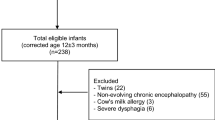Abstract
In this prospective study, birth weight of 304 babies born at Kamla Nehru Hospital Pune during study period was recorded. From these 304 babies, babies with birth weight above 2000 grams were selected (260 babies) to prepare growth velocity curves. Daily weight of these 260 babies was recorded for 30 days. The mean birth weight of study population was 2742.5 grams. Among the daily weight recorded babies, all the babies lost weight ranging from 92 to 218 grams (mean 121 grams) after birth. The weight loss continued upto 5 days. Days required to gain weight equal to birth weight ranged from 5 to 13 days. Total weight gain observed in 30 days was 734.7 grams. Predictive value of these curves was tested in 49 infants. Deviation upto 50 grams of predicted birth weight from actual birth weight was observed in 90% of babies on day-2, 79% on day-4, 65% on day-8 and 39% on day-30.
Similar content being viewed by others
References
McCormick MC. The contribution of low birth to infant mortality and childhood mortality.New Engl Med 1985; 313: 82–90.
Registrar General and Census Commissioner of India.Provisional population total of India. Census of India, 1992; 1: 3–4.
UNICEF-ICMR report. Birth weight, a major determinant of child survival.Ind J Pediatr 1987; 54: 801–804.
Pachauri S, Marwah SM, Rao NSN. A multifactorial approach to the study of the factors influencing birth weight in the urban community of New Delhi.Indian J Med Res 1971; 59: 1318–1339.
Das K, Ganguli SSet al. Interrelationship of birth weight with certain biological and socioeconomic factors.Indian J Publ Hlth 1981; 25: 11–19.
Badole CM, Tyagi NK, Agarwal M. Fetal growth, association with maternal dietary intake, hemoglobin and antenatal care in rural areas.J Obstet and Gynecol 1991; 97: 32–36.
Chadha VK, Bachani Det al. Nutritional status of urban poor mothers and birth weight.J Obstet and Gynecol 1992; 98: 278–282.
Gopalan S, Puri RK. Breast feeding and infant growth.Indian Pediatr 1992; 29: 1079–1086.
Purohit M, Purohit Net al. Physical growth of Indian infants from birth to six months.Indian J Pediatr 1977; 44: 289–292.
Infant feeding, the physiological basis. World Health Organization.Bull WHO, 67 (supplement): 9–18.
Ghai OP. Growth and development,Essential Pediatrics. New Delhi: Interprint, 1990.
Pratinidhi AK, Shrotri AN, Shah Uet al. Domiciliary care of low birth weight neonates.Indian J Pediatr 1986; 53: 87–92.
Author information
Authors and Affiliations
Rights and permissions
About this article
Cite this article
Pawar, S.D., Patil, A.V. & Pratinidhi, A.K. Retrospective prediction of birth weight by growth velocity curves during neonatal period. Indian J Pediatr 63, 385–392 (1996). https://doi.org/10.1007/BF02751536
Issue Date:
DOI: https://doi.org/10.1007/BF02751536




